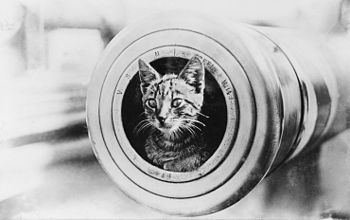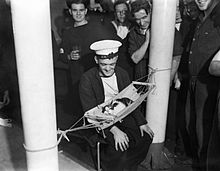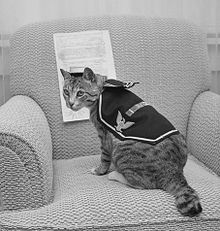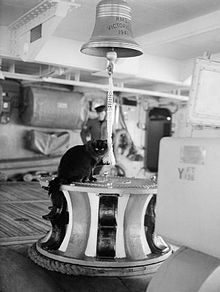- Ship's cat
-
 Prime Minister Winston Churchill encounters a ship's cat. He restrains Blackie, the mascot of HMS Prince of Wales, from joining an American destroyer, while the ship's company stand to attention during the playing of the National Anthem.
Prime Minister Winston Churchill encounters a ship's cat. He restrains Blackie, the mascot of HMS Prince of Wales, from joining an American destroyer, while the ship's company stand to attention during the playing of the National Anthem.
The ship's cat has been a common sight on many trading, exploration, and naval ships, and is a phenomenon that goes back to ancient times. Cats have been carried on ships for a number of reasons, the most important being to catch mice and rats. These rodents, when aboard, could cause considerable damage to ropes and woodwork. More serious was the threat rodents posed to the stores the ship carried. Not only could they devour the foodstuff carried to feed the crew, they could cause economic damage if the ship was carrying grain or similar substances as part of its cargo. Rats and mice were also sources of disease, an important consideration for ships which could be at sea for long periods of time. Cats naturally attack and kill these rodents.[1]
Cats have a high ability to adapt to new surroundings, and were therefore highly suitable for service on a ship. They also offered companionship and a sense of home and security to sailors who could be away from home for long periods, especially in times of war.
Contents
Early history
The domestication of cats is believed to date back some 9,500 years, and the practice of taking cats aboard boats and ships began not long afterwards. The Ancient Egyptians took cats on board Nile boats to catch birds in the thickets along the riverbanks.[2] Cats were also carried on trading ships to control rodents, and that concept was adopted by traders from other nations. This led to the spread of cats throughout the world, with the species eventually reaching nearly all parts of the world accessible by ship. Over the centuries their offspring developed into different breeds according to the climate in which they found themselves and the mates they took, as well as the deliberate selection by humans. Phoenician cargo ships are thought to have brought the first domesticated cats to Europe in about 900 BC.
Cats and superstition
Sometimes worshipped as deities, cats have long had a reputation as magical animals and numerous myths and superstitions sprang up amongst the unusually superstitious seafaring community.[3] They were considered to be intelligent and lucky animals, and a high level of care was directed toward them to keep them happy. Some sailors believed that polydactyl cats were better at catching pests, possibly connected with the suggestion that extra digits give a polydactyl cat better balance, important when at sea. In some places polydactyl cats became known as "ship's cats".
Cats were believed to have miraculous powers that could protect ships from dangerous weather. Sometimes, fishermen's wives would keep black cats at home too, in the hope that they would be able to use their influence to protect their husbands at sea. It was believed to be lucky if a cat approached a sailor on deck, but unlucky if it only came halfway, and then retreated. Another popular belief was that cats could start storms through magic stored in their tails. If a ship's cat fell or was thrown overboard, it was thought that it would summon a terrible storm to sink the ship and that if the ship was able to survive, it would be cursed with nine years of bad luck. Other beliefs included, if a cat licked its fur against the grain, it meant a hailstorm was coming; if it sneezed it meant rain; and if it was frisky it meant wind.
Some of these beliefs are rooted in reality. Cats are able to detect slight changes in the weather, as a result of their very sensitive inner ears, which also allow them to land upright when falling. Low atmospheric pressure, a common precursor of stormy weather, often makes cats nervous and restless.[citation needed]
Famous ship's cats
The prevalence of cats on ships has led to them being reported on by a number of famous seafarers. The outbreak of the Second World War, with the spread of mass communication and the active nature of the world's navies, also led to a number of ship's cats becoming celebrities in their own right.[4]
Blackie
Blackie was HMS Prince of Wales's ship's cat. During the Second World War, he achieved worldwide fame after Prince of Wales carried Prime Minister Winston Churchill across the Atlantic to NS Argentia, Newfoundland, where he secretly met with the United States President Franklin D. Roosevelt for several days in a secure anchorage. This meeting resulted in the signing of the Atlantic Charter, but as Churchill prepared to step off Prince of Wales, Blackie approached. Churchill stooped to bid farewell to Blackie, and the moment was photographed and reported in the world media. In honour of the success of the visit, Blackie was renamed Churchill.[5]
Camouflage
Camouflage was the ship's cat aboard an LST. He was known for chasing enemy tracer rounds across the deck.[6]
Chibbley
Chibbley was the ship's cat aboard the tall ship, Picton Castle. She was rescued from an animal shelter and circumnavigated the world five times. The Picton Castle’s role as a training ship resulted in Chibbley being introduced to a large number of visitors, and becoming a celebrity in her own right, receiving her own fan mail.[7] Chibbley passed away on Nov. 10, 2011, in Lunenburg, Nova Scotia. She had sailed over 180,000 miles at sea.
Convoy
Convoy was the ship's cat aboard HMS Hermione. He was so named because of the number of times he accompanied the ship on convoy escort duties. Convoy was duly listed in the ship's book and provided with a full kit, including a tiny hammock where he would sleep. He stood by his ship to the end and was lost along with 87 of his crew mates, when the Hermione was torpedoed and sunk on 16 June 1942 by U-205.
Emmy
Emmy was the ship's cat on the RMS Empress of Ireland. She was an orange tabby cat who never missed a voyage. However, on May 28, 1914, Emmy tried to escape the ship. The crew could not coax her aboard and the Empress left without her. She was reportedly last seen on the roof of the shed at Pier 27, watching her ship sail out of Quebec City. Early the next morning the Empress collided with the SS Storstad while steaming through fog at the mouth of the St. Lawrence river and rapidly sank, killing over 1,000 people (including eight more passengers than had died on the also ill-fated RMS Titanic over two years earlier).
Felix
Felix was the ship's cat aboard the Mayflower II when it set sail from Devon, England, to Plymouth, Massachusetts, U.S.A., in 1957 to symbolize the solidarity between the two countries following World War II. He was given his own life jacket and once suffered a broken paw after a mishap. The paw was set by the ship's doctor. Photos and stories about Felix appeared in National Geographic, Life, and Yankee magazine after his arrival in the U.S. The cat and the rest of the crew marched in a New York ticker tape parade and toured the East Coast that summer. He was eventually adopted by the cabin boy's girlfriend, Ann Berry, and settled in Waltham, Massachusetts. The current captain of the Mayflower II wrote a children's book about Felix entitled Felix and his Mayflower II Adventures. The book was published during the celebration of the ship's fiftieth anniversary at Plimoth Plantation.[8]
Kiddo
Kiddo seemed to have stowed away on the airship America, when she left from Atlantic City, New Jersey, in an attempt to cross the Atlantic Ocean in 1910. Kiddo was upset at first by the experience, but settled in and evidently, was better at predicting bad weather than the barometer. The airship's engines failed, and the small crew and Kiddo abandoned the America for lifeboats when they sighted the Royal Mail steamship, Trent, near Bermuda. Kiddo then was retired from being a ship's cat and was taken care of by Edith Wellman Ainsworth, the daughter of the American journalist, explorer, and aviator, Walter Wellman, who made the daring attempt.[9]
Mr Riley
Ship's cat on USS Texas (1892) 1898-1899 war. See [10]
Mrs. Chippy
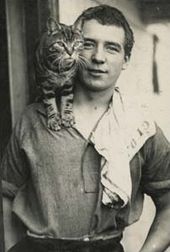 Mrs. Chippy, a tiger-striped male tabby ship's cat.
Mrs. Chippy, a tiger-striped male tabby ship's cat. Main article: Mrs. Chippy
Main article: Mrs. ChippyMrs. Chippy was the ship's cat aboard Endurance, the ship used by Sir Ernest Shackleton for his Imperial Trans-Antarctic Expedition. When the ship was lost, having become trapped and eventually crushed in pack ice, the sled dogs and Mrs. Chippy had to be put down, as they would not have survived the arduous journey ahead.
Nansen
Nansen was the ship's cat on the Belgica, which was used for the Belgian Antarctic Expedition. He was brought on board by cabin boy Johan Koren, and was named after Fridtjof Nansen. He died on 22 June 1898,[11] and was buried in the Antarctic.[12]
Peebles
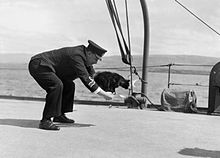 Lieutenant Commander R H Palmer OBE, RNVR plays with Peebles, the ship's cat, who leaps through his clasped arms on board HMS Western Isles, at Tobermory, Mull
Lieutenant Commander R H Palmer OBE, RNVR plays with Peebles, the ship's cat, who leaps through his clasped arms on board HMS Western Isles, at Tobermory, Mull
Peebles was the ship's cat aboard HMS Western Isles. Another cat who became a favourite of the ship's crew, he was known to be particularly intelligent and would shake the hands of strangers when they entered the wardroom. Peebles is seen at the right on top of the deck, participating in a game of jump through the hoop during the Second World War.
Pooli
Pooli served aboard a United States attack transport during the Second World War. Here she is pictured on her fifteenth birthday. Pooli, a veteran who rates three service ribbons and four battle stars, shows she can still get into her old uniform. [13]
Simon
Main article: Simon (cat)Simon was the ship's cat of HMS Amethyst during the Yangtze Incident in 1949, and was wounded in the bombardment of the ship which killed 25 of Amethyst’s crew, including her commanding officer. He soon recovered and resumed killing rats and keeping up the crew's morale. He was appointed to the rank of 'Able Seacat' Simon and became a celebrity after the ship escaped the Yangtze and returned to Britain. He later succumbed to an infection and died shortly after. Tributes poured in and his obituary appeared in The Times. He was posthumously awarded the Dickin Medal, the only cat ever to earn the award, and was buried with full naval honours.
Tarawa
Tarawa was a kitten rescued from a pillbox during the Battle of Tarawa by the United States Coast Guard and named Tarawa. She was a mascot aboard an LST, but did not get along with the LST's other mascot, a dog named Kodiak, and jumped ship ashore.[14]
Tiddles
Tiddles was the ship's cat on a number of Royal Navy aircraft carriers. He was born aboard HMS Argus, and later joined HMS Victorious. He was often seen at his favourite station, on the after capstan, where he would play with the bell-rope. He eventually travelled over 30,000 miles (48,000 km) during his time in service.
Trim
Main article: Trim (cat)Trim was the ship's cat on a number of the ships under the command of Matthew Flinders during voyages to circumnavigate and map the coastline of Australia during 1801-03. He became a favourite of the crew and was the first cat to circumnavigate Australia. He remained with Flinders, until apparently being stolen and eaten by hungry slaves. A statue to Trim was later erected in his honour, and he has been the subject of a number of works of literature. A statue sits on a window sill on the outside of the Sydney Library, in Sydney, Australia.
Trim's statue behind Matthew Flinders' own in Sydney, Australia. The plaque under it says:
TO THE MEMORY OF TRIM
The best and most illustrious of his race
The most affectionate of friends,
faithful of servants,
and best of creatures
He made the tour of the globe, and a voyage to Australia,
which he circumnavigated, and was ever the
delight and pleasure of his fellow voyagers........
Written by Matthew Flinders in memory of his cat
Memorial donated by the North Shore Historical Society.U-boat
U-boat was another ship's cat aboard a Royal Navy vessel in the Second World War, who would take ‘shore leave’ whenever his ship came into port. He would spend days on shore, usually returning only just before his ship sailed. One day, U-boat failed to return in time for roll call and his ship was forced to sail. As she pulled away from the quay, U-boat was seen running down the dock after the departing ship. He made a death-defying leap onto the ship and succeeded in making it aboard. He was reported to be undaunted by his experience, proceeding to wash himself on deck. The crew members were apparently delighted their good luck charm had returned.[citation needed]
Unsinkable Sam
Main article: Unsinkable SamPreviously named Oscar, he was the ship's cat of the German battleship Bismarck. When she was sunk on 27 May 1941, only 116 out of a crew of over 2,200 survived. Luckily, Oscar was picked up by the destroyer HMS Cossack. Cossack herself was torpedoed and sunk a few months later, on 24 October, killing 159 of her crew, but again, Oscar survived to be rescued, and was taken to Gibraltar. He became the ship's cat of HMS Ark Royal but she too was torpedoed and sunk in November that year. Oscar was again rescued, but it was decided at that time to transfer him to a home on land. By now known as Unsinkable Sam, he was given a new job as mouse-catcher in the Governor General of Gibraltar's office buildings. He eventually returned to the UK and spent the rest of his life at the 'Home for Sailors'. A portrait of him hangs in the National Maritime Museum in Greenwich.
Ship's cats today
The Royal Navy banned cats and other pet animals from all ships on the ocean in 1975 on hygiene grounds.[4]
Cats are still present on many private ships, such as Chibbley aboard the barque Picton Castle,[15] and Toolbox on board Kalmar Nyckel.
Fictional ship's cats
There are three books with the title "The Ship's Cat", by Jock Brandis, Richard Adams and James Aldridge.
In a central episode in Jan de Hartog's novel The Captain, taking place on board a ship engaged in the dangerous Murmansk Convoys in the Second World War, a young officer is killed in an effort to save the ship's cat and her playful kittens during a Luftwaffe attack on the ship. This profoundly affects the main protagonist, the ship's captain, and is one of the factors leading to his later becoming a conscientious objector.
A modern, fictional example is that of Jones, from the 1979 film Alien. Lt. Ripley is so attached to a tabby cat that she makes a specific point of rescuing him from the exploding Nostromo.
In the video game Halo, there are posters for a missing cat named Jonesey onboard the human ships. This is a possible reference to the cat from the science fiction film Alien.
Lucifer Sam by Pink Floyd (Syd Barrett) makes reference to Sam being a Ship's Cat
"Below Decks" was a fictitious cat aboard the submarine USS Miami. Shortly after she was commissioned in 1990, one of the ship's radiomen with a penchant for comedic postings placed a "missing cat" poster in the ship's passageway while the ship was underway. The poster described the cat as a black and white cat, about one year old, and answering to the name "Below Decks."
A number of science fiction writers have transferred the institution of a ship's cat to interstellar spaceships of the far future. One of the earlier examples is Cordwainer Smith's short story "The Game of Rat and Dragon".[16] For example, in her novel The Zero Stone, Andre Norton features ship cats which are also telepathic.[17] David Weber's Honorverse novels feature 'treecats' that can bond with naval officers and accompany them aboard spaceships, and at least one instance of a ship having a real cat aboard. Joe Haldeman's Forever War also features a ship's cat.
Spot, a cat owned by Lt. Commander Data in Star Trek: The Next Generation, could be considered the ship's cat of the Enterprise-D, despite not being the only cat aboard the ship.
Cat, from the British sci-fi sitcom Red Dwarf, is another example. See Cat (Red Dwarf). The character has no name other than "The Cat" or simply "Cat". He is the humanoid descendant of a modern domestic cat called Frankenstein who had been Dave Lister's pregnant pet cat. He may be the last remaining member of his species, Felis sapiens.
The children's book The Mousehole Cat by Antonia Barber tales the story of a cat who owns an old Cornish fisherman who accompanies him on Sea Voyages.
In An Episode of Gomer Pyle, U.S.M.C., Gomer brings a pregnant cat onboard a navy ship while on sea maneuvers.
See also
- The Ship's Cat (Novel)
- The Adventures & Brave Deeds Of The Ship's Cat On The Spanish Maine: Together With The Most Lamentable Losse Of The Alcestis & Triumphant Firing Of The Port Of Chagres (Children's book)
- Jennie (Novel) by Paul Gallico
References
- ^ Bruzelius, Lars (2005). "Sailing Ships". Stevens:"Vermin", 1894. The Maritime History Virtual Archives. http://www.bruzelius.info/Nautica/Seamanship/Stevens%281894%29_S1156.html. Retrieved Apr. 20, 2010.
- ^ Simon of HMS Amethyst
- ^ Eyers, Jonathan (2011). Don't Shoot the Albatross!: Nautical Myths and Superstitions. A&C Black, London, UK. ISBN 978-1-4081-3131-2.
- ^ a b Famous ships cats and their lives
- ^ Royal Navy cats
- ^ [1] US Coast Guard Mascot page
- ^ An interview with Chibbley
- ^ The Journey of the Mayflower II - Felix
- ^ Janus, Allan (October 15, 2005). Animals Aloft: Photographs from the Smithsonian National Air & Space Museum. Bunker Hill Publishing. pp. 128. ISBN 1593730489.
- ^ Munsey's Magazine Vol 20.p.26
- ^ Lewis, Val (2002). Ship's Cats in War and Peace. Shepperton: Nauticalia Ltd. pp. 59–60. ISBN 0953045811.
- ^ "Adrien de Gerlache, Belgica Belgian Antarctic Expedition 1897 - 1899". Cool Antarctica. http://www.coolantarctica.com/Antarctica%20fact%20file/History/antarctic_whos_who_belgica.htm. Retrieved 5 October 2010.
- ^ Los Angeles Times, July 4, 1959
- ^ [2] US COast Guard Mascot page
- ^ Chibbley's travels aboard Barque Picton Castle
- ^ [3] Smith, Cordwainer, "The game of Rat and Dragon" Galaxy Science Fiction, October 1955
- ^ http://www.amazon.com/Zero-Stone-Andre-Norton/dp/0441959644
- Lewis, Val (2001). Ships' Cats in War and Peace. Nauticalia. ISBN 978-0953045815
- Roberts, Patrick. "Pur-n-Fur: Famous Felines". http://www.purr-n-fur.org.uk/famous/simon.html
External links
Categories:- Military animals
- Marine occupations
- Maritime history
- Mascots
- Individual cats
- Cat types
Wikimedia Foundation. 2010.

